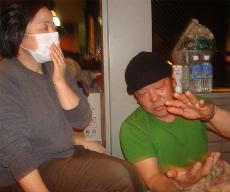By: John M. Glionna/MCT Campus
Posted In: News

Photo credit: John M. Glionna/MCT Campus
Kuniko Suzuki and her husband, Tsutomu, get ready for bed at a refugee center in Tagajo, Japan. They sleep on the floor with the other five members of their family.
TAGAJO, Japan – Tsutomu Suzuki’s world is 6 feet long by 12 feet wide, a crude refuge he and his family of five have staked out in an upstairs lobby of the Tagajo cultural center.
They sleep side by side on the tile floor, with only blankets to cushion them. It’s like camping indoors, although sometimes it’s almost as cold as the outdoors. But there is one luxury that sets them apart from others at the crowded shelter: the couch. It’s not much to look at – a cheap stick of furniture salvaged from a motel. But for Suzuki, a 52-year-old carpenter in black cap and green T-shirt, it’s a reminder of a better life. His wife, Kuniko, 50, and her mother, 78-year-old Kimiko Takahashi, often lounge on it and pretend they’re back in the living room of their modest home. But even this simple pleasure has its drawbacks. “The couch is so narrow my wife often rolls off in the middle of the night and comes crashing down on top of me,” Tsutomu said. Within an hour of the March 11 earthquake, Kuniko and her mother had found refuge at the modern two-story center in this provincial city 220 miles north of Tokyo. The following day, Tsutomu brought the couple’s daughter, Ikue, 18, and his wife’s sister, Chikako. Life on the floor is not the hardest part, they say; it’s not knowing how long their purgatory will last. The center houses 550 of the 160,000 people still in shelters as a result of the earthquake and tsunami. On a recent night, Tsutomu surveyed his surroundings, teeming with fellow refugees. Blankets were spread everywhere: in hallways, meeting rooms and exhibit spaces. Enterprising neighbors had draped blankets over chairs to create a roof or had fashioned cardboard walls for a sense of separation. With people packed so closely, privacy is at a premium. Kuniko holds up a blanket so Ikue can dress in the morning without being seen by young men. The grandmother insists conditions are better than those she faced after World War II. Still, life is hard. The elderly woman sometimes soils herself before she can reach one of the few toilets. None of the Suzukis has showered in weeks. Baths consist of a bucket of cold water. “You don’t know how much you miss a hot shower until you can’t have one,” Tsutomu said. The night brings little respite. The overhead lights never dim. With only two electric space heaters, many refugees wear jackets under the covers and still shiver amid indoor temperatures that plunge to the mid-30s. Residents twitch and fidget. Many call out in their sleep; others snore and cough incessantly. Restless, up by 5 a.m., some scan the many notes on a message board, like one that reads: “Yuriko, I came to get you but couldn’t find you. Don’t worry, I’ll be back. I hope you’re safe.” Time drags. The monotony is prison-like. Meals are spartan. “There’s no way to get these people the calories they need,” said Satou Tadamichi, vice chief of the center, a compact man with black hair and a graying beard. On a recent day, the menu consisted of two slices of bread for breakfast and half an apple and one slice of bread for lunch. Dinner was rice,Jealousies over food often surface. Residents complain of being shortchanged and accuse others of receiving more than their share. “Many people are holding so much grief, I fear one day they’re just going to explode over something as simple as a bowl of rice,” Tadamichi said. There’s the man who paces for hours at a time; the woman who insists she now hates the sea; the child who wets her bed as she dreams of being chased by a mammoth wave. Masuko Iwai, 72, suffers a recurring nightmare. The moment she closes her eyes, a voice calls to her, pleading for help she cannot give. They’re the cries of a neighbor swept away by the tsunami. “She shouts, ‘Masuko, help me, help me!’ ” she said. “I answer, ‘I’ll go! Please tell me where to go!’ But the others tell me I must be quiet, that I need my rest. But how can I ignore that voice?” Physician Jyunya Minohata sees patients in a makeshift clinic under a staircase. He treats the rampant cold and flu, but there’s little he can do for emotional distress. “Stress levels here are high,” said Minohata, 35. “People have lost so much. And the emotional damage has started to surface.” Nearby, a wafer-thin man in his early 40s doubled over and clutched his stomach. A nurse led him to a chair and rubbed his shoulders as the doctor crouched low, whispering in his ear. For weeks, the scene has been repeated: The patient insists someone changed his medication. “We can’t convince him otherwise,” Minohata said. “He calms down. Then he returns the next day.” Kiko Iwamoto, a social worker who specializes in grief and bereavement, worries that disaster victims are not getting psychological counseling they desperately need, a concern in a culture where such therapy is frowned upon. “These centers need a place where victims can talk about their losses and be reassured they’re not the only ones,” she said. Iwai has developed her own coping mechanism. For the first week, with no electricity, the nights were pitch-black and cold. “Then the aftershocks came,” she said. “People screamed and ran for the door. We were on a ship riding a wave at sea. I cried, saying, ‘What did I do to deserve this?'” But she soon made friends. A group of elderly women moved together into a corner, where they share food and support. “We remind ourselves that everyone here is a victim,” Iwai said. At 9:30 on a recent night, a security guard switched off the center’s only TV and a loudspeaker broadcast the day’s final announcement: “Please go to bed,” a woman’s voice said. “Be silent.” Tsutomu kissed his wife and hit the floor; it was her turn on the couch. Not far away, Iwai headed off to bed, knowing the voice would be there to greet her.











